9.8K

 Tel Aviv is home to the biggest Bauhaus heritage in the world, a collection of more than four thousands buildings that were constructed by the Jewish architects who moved here from Germany during the 1930s.
Tel Aviv is home to the biggest Bauhaus heritage in the world, a collection of more than four thousands buildings that were constructed by the Jewish architects who moved here from Germany during the 1930s.










 The main reason I wanted to stop in Haifa was to check out the psychedelic-pop production by my beloved Broken Fingaz Crew, and so, after the initial disappointment when I discovered that there was no club Kartel anymore, I climbed uptown as far as the hipster area of Haifa: Masada Street.
The main reason I wanted to stop in Haifa was to check out the psychedelic-pop production by my beloved Broken Fingaz Crew, and so, after the initial disappointment when I discovered that there was no club Kartel anymore, I climbed uptown as far as the hipster area of Haifa: Masada Street.

 Unfortunately, on that day I couldn’t manage to meet with the Broken Fingaz Crew, but still I was determined to see Haifa through their eyes, and so I went to the area of Wadi Nisnas to find what they wrote me: it was their favourite falafel place in the city. Wadi Nisnas is the Arab neighbourhood of Haifa, built around a Middle Eastern bazaar and characterized by narrow alleys and stone buildings.
Unfortunately, on that day I couldn’t manage to meet with the Broken Fingaz Crew, but still I was determined to see Haifa through their eyes, and so I went to the area of Wadi Nisnas to find what they wrote me: it was their favourite falafel place in the city. Wadi Nisnas is the Arab neighbourhood of Haifa, built around a Middle Eastern bazaar and characterized by narrow alleys and stone buildings.

 I tried to visit the UNESCO-listed Baha’i Gardens, which were closed, so I just peeked through the gates. Not bad anyway, since I could look out over the beautiful terraces as far as the sea.
I tried to visit the UNESCO-listed Baha’i Gardens, which were closed, so I just peeked through the gates. Not bad anyway, since I could look out over the beautiful terraces as far as the sea.
 Haifa is built over the slope of a mountain, so wherever I stopped I could enjoy the beautiful view of the narrow staircases between the limestone buildings running towards the sea like small rivers.
Haifa is built over the slope of a mountain, so wherever I stopped I could enjoy the beautiful view of the narrow staircases between the limestone buildings running towards the sea like small rivers.





 The reason why I went to Zefat was to visit its Jewish Cemetery, whose notable tombstones are painted in blue, a colour that symbolizes the union between earth and sky, which was represented by the Kabbalah masters who are buried there.
The reason why I went to Zefat was to visit its Jewish Cemetery, whose notable tombstones are painted in blue, a colour that symbolizes the union between earth and sky, which was represented by the Kabbalah masters who are buried there.




 Seen from above, the cemetery looks like a bewitched city enlivened only by the chanting prayers lingering between blue-painted tombstones surfacing from the fog. I was the only foreign around, although the city looks like it might get quite crowded in high season.
Seen from above, the cemetery looks like a bewitched city enlivened only by the chanting prayers lingering between blue-painted tombstones surfacing from the fog. I was the only foreign around, although the city looks like it might get quite crowded in high season.




 However, when I visited it, on its cobbled streets there were only Chassidim Jews and ex-hippies, the majority of whom moved here from the United States during the 1960s.
However, when I visited it, on its cobbled streets there were only Chassidim Jews and ex-hippies, the majority of whom moved here from the United States during the 1960s.
 Back in the old city, I found a winery and stopped for a glass of local cabernet from 2014, aged 26 months, which was exceptional as all the wines from the Golan region. There I spent the rest of the afternoon writing, reading, and tasting the local cheese, Gvina Tzfatit, which is salty yet delicious, together with some Lachuch, the Yemenite flat bread.
Back in the old city, I found a winery and stopped for a glass of local cabernet from 2014, aged 26 months, which was exceptional as all the wines from the Golan region. There I spent the rest of the afternoon writing, reading, and tasting the local cheese, Gvina Tzfatit, which is salty yet delicious, together with some Lachuch, the Yemenite flat bread.
 After that foggy day cosying up with some good food and an even greater red wine, I was ready to go back to the warmer temperatures of Southern Israel.
After that foggy day cosying up with some good food and an even greater red wine, I was ready to go back to the warmer temperatures of Southern Israel.



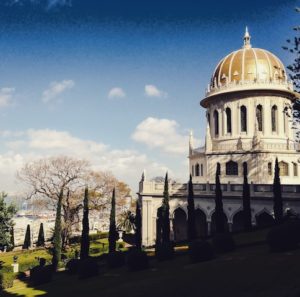 (Actually, not all of them; this is just the first article about my trip to Israel and it covers only Tel Aviv, Haifa, and Zefat)
(Actually, not all of them; this is just the first article about my trip to Israel and it covers only Tel Aviv, Haifa, and Zefat)
When I landed in Tel Aviv, I was still laughing. Although it took almost two hours, the security check at Rome Airport was hilarious. Well-known for its paranoia, the Al El’s staff dragged me into an interrogation room and urged me with questions on what I had for breakfast. Because –you know- you can tell if someone is a terrorist by how they begin the day.
The guards wrote down all the names of the people I was going to meet during my trip to Israel: first names only, without other useful information such as surnames or what my Israeli friends have for breakfast.
I was asked to wait inside a tiny room, and while I was imprisoned there, for unknown reasons, my passport passed through dozens of hands until it eventually got labelled with a red, high-danger stamp.
However, during this in-depth security check, they forgot to verify one thing: if I was flying with their company -which I wasn’t.
Trip to Israel > Tel Aviv
It was just March, but the air was already pretty warm. It was enhanced with golden sand, which made the city look charming and seductively winking at me. Because yes, Tel Aviv is sexy. Its cosmopolitan community chills out on the wide beaches, dances on the rooftops, and sips coffees al fresco. The city is a hub of start-uppers, designers and artists, and it has a huge expat community coming from all over the world.

The sunshine reflects either on the sea or on the glassy skyscrapers that make up the iconic skyline of the city, although Tel Aviv isn’t all skyscrapers and banks; there are also smaller houses with personality, windows all different from each others, shop signs showing off different fonts (I love Jewish fonts!) and a lot of spontaneous street art.

A walk through the Levinsky Spice Market is an assault to the senses, as is the taste of the Israeli food, which I tried for the first time in Tel Aviv. Already on my first day in Tel Aviv, I swore that I would never ever eat hummus outside Israel. I had so many falafels, and I was always sipping some type of fresh juice: orange, pomegranate or some weird Israeli mix.
 Tel Aviv is home to the biggest Bauhaus heritage in the world, a collection of more than four thousands buildings that were constructed by the Jewish architects who moved here from Germany during the 1930s.
Tel Aviv is home to the biggest Bauhaus heritage in the world, a collection of more than four thousands buildings that were constructed by the Jewish architects who moved here from Germany during the 1930s.

However, despite the rational urban planning and the clean, Bauhaus-y geometry, this dynamic city still feels very chaotic. Cars and people are everywhere, although there are also a few spots where the town backs off: the promenade along the sea, the panoramic rooftops (check out the stunning view from the top of this car parking!), the old neighbourhood of Neve Tzedek, and the hipster area of the Florentin, which is where you will find the best street art in Tel Aviv.




I visited Tel Aviv during Purim, which is the second best party in the city after the legendary gay pride in June. Purim commemorates the salvation of the Jewish people from annihilation in ancient Persia and dates back to 2500 years ago.
Today, it’s the perfect opportunity for Tel Aviv’s fun-loving residents to dress up, dance and drink “until they can’t tell good from bad.”


Trip to Israel > Haifa
The train runs along the blue sea as far as Haifa station. I left the backpack at the baggage storage and hit the city, heading to the legendary club Kartel. The former boat hanger covered with graffiti had been a hotspot for underground culture for decades, but unfortunately, now it’s permanently closed (and I found all the amazing street art covered with scaffoldings, to boot!).

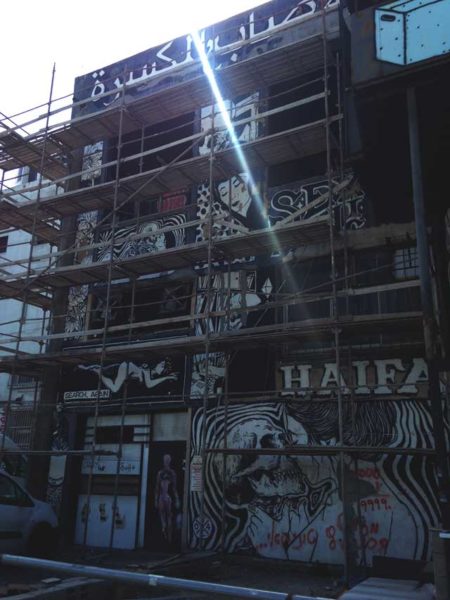
 The main reason I wanted to stop in Haifa was to check out the psychedelic-pop production by my beloved Broken Fingaz Crew, and so, after the initial disappointment when I discovered that there was no club Kartel anymore, I climbed uptown as far as the hipster area of Haifa: Masada Street.
The main reason I wanted to stop in Haifa was to check out the psychedelic-pop production by my beloved Broken Fingaz Crew, and so, after the initial disappointment when I discovered that there was no club Kartel anymore, I climbed uptown as far as the hipster area of Haifa: Masada Street.
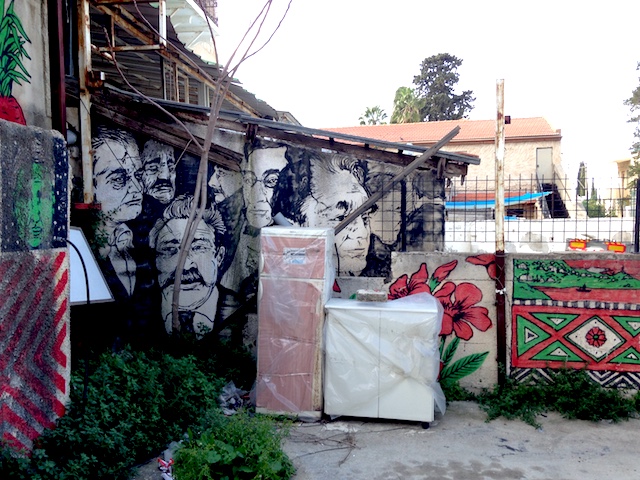 Unfortunately, on that day I couldn’t manage to meet with the Broken Fingaz Crew, but still I was determined to see Haifa through their eyes, and so I went to the area of Wadi Nisnas to find what they wrote me: it was their favourite falafel place in the city. Wadi Nisnas is the Arab neighbourhood of Haifa, built around a Middle Eastern bazaar and characterized by narrow alleys and stone buildings.
Unfortunately, on that day I couldn’t manage to meet with the Broken Fingaz Crew, but still I was determined to see Haifa through their eyes, and so I went to the area of Wadi Nisnas to find what they wrote me: it was their favourite falafel place in the city. Wadi Nisnas is the Arab neighbourhood of Haifa, built around a Middle Eastern bazaar and characterized by narrow alleys and stone buildings.
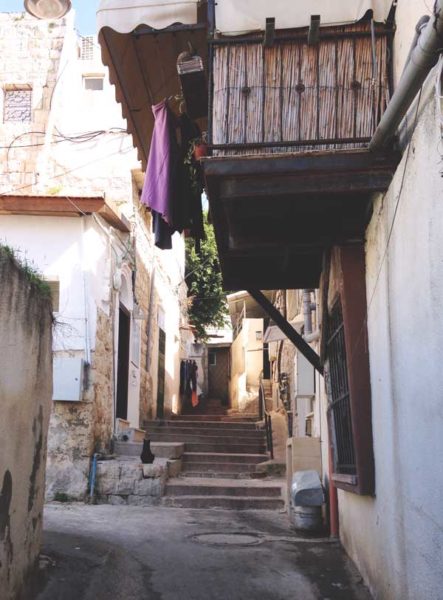 I tried to visit the UNESCO-listed Baha’i Gardens, which were closed, so I just peeked through the gates. Not bad anyway, since I could look out over the beautiful terraces as far as the sea.
I tried to visit the UNESCO-listed Baha’i Gardens, which were closed, so I just peeked through the gates. Not bad anyway, since I could look out over the beautiful terraces as far as the sea. Haifa is built over the slope of a mountain, so wherever I stopped I could enjoy the beautiful view of the narrow staircases between the limestone buildings running towards the sea like small rivers.
Haifa is built over the slope of a mountain, so wherever I stopped I could enjoy the beautiful view of the narrow staircases between the limestone buildings running towards the sea like small rivers.
The last area I visited was the German Colony, where the city gets unequivocally tidier and the streets smell of jasmine. Here I wandered around the small houses, which are so unusual with their sloping red roofs, until it was time to meet my friend, Tarik, whom I lived with during my first year living in Slovenia.
My friend is part of the ethnic minority of Druze people, who speaks Arab but enlist in the Israeli army. He kindly welcomed me to his house, where I helped his mom cook a traditional dinner, finally learning how to properly chop parsley for the tabbulé.
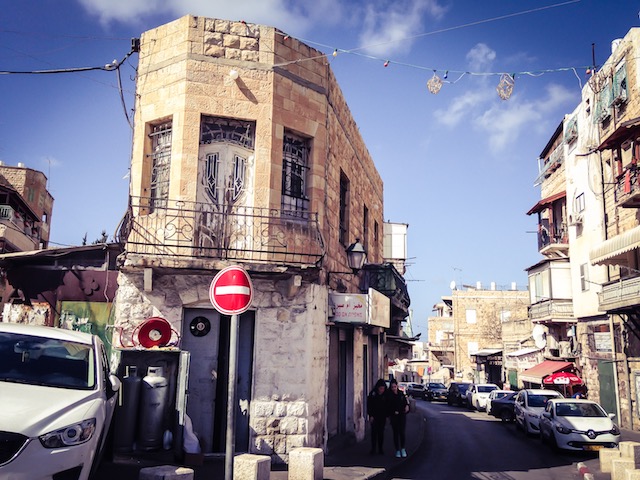

Trip to Israel > Zefat
The next morning, I took a bus to Northern Galilee to visit the holy city of Tsfat, which is the most important centre of Kabbalah in the world. Jewish mysticism lingers in this city like the fog that, on that morning, was wrapping up its synagogues and its minarets. It hovers on its neglected buildings and along the narrow cobbled alleys, whose beautiful stone houses are dotted with blue gates.


 The reason why I went to Zefat was to visit its Jewish Cemetery, whose notable tombstones are painted in blue, a colour that symbolizes the union between earth and sky, which was represented by the Kabbalah masters who are buried there.
The reason why I went to Zefat was to visit its Jewish Cemetery, whose notable tombstones are painted in blue, a colour that symbolizes the union between earth and sky, which was represented by the Kabbalah masters who are buried there.
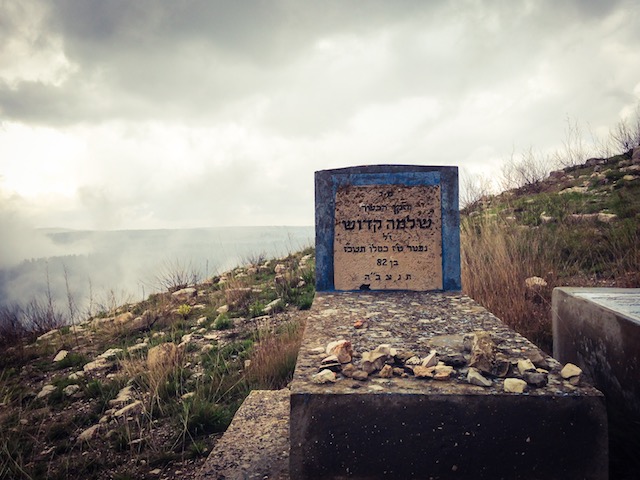


 Seen from above, the cemetery looks like a bewitched city enlivened only by the chanting prayers lingering between blue-painted tombstones surfacing from the fog. I was the only foreign around, although the city looks like it might get quite crowded in high season.
Seen from above, the cemetery looks like a bewitched city enlivened only by the chanting prayers lingering between blue-painted tombstones surfacing from the fog. I was the only foreign around, although the city looks like it might get quite crowded in high season.



 However, when I visited it, on its cobbled streets there were only Chassidim Jews and ex-hippies, the majority of whom moved here from the United States during the 1960s.
However, when I visited it, on its cobbled streets there were only Chassidim Jews and ex-hippies, the majority of whom moved here from the United States during the 1960s.
 Back in the old city, I found a winery and stopped for a glass of local cabernet from 2014, aged 26 months, which was exceptional as all the wines from the Golan region. There I spent the rest of the afternoon writing, reading, and tasting the local cheese, Gvina Tzfatit, which is salty yet delicious, together with some Lachuch, the Yemenite flat bread.
Back in the old city, I found a winery and stopped for a glass of local cabernet from 2014, aged 26 months, which was exceptional as all the wines from the Golan region. There I spent the rest of the afternoon writing, reading, and tasting the local cheese, Gvina Tzfatit, which is salty yet delicious, together with some Lachuch, the Yemenite flat bread. After that foggy day cosying up with some good food and an even greater red wine, I was ready to go back to the warmer temperatures of Southern Israel.
After that foggy day cosying up with some good food and an even greater red wine, I was ready to go back to the warmer temperatures of Southern Israel.But that’s another story (coming soon!).
You can hover over these (or any) images to quickly pin it!



PEEK THROUGH || Check out my short video “2 weeks in Israel and Palestine… in 2 minutes“